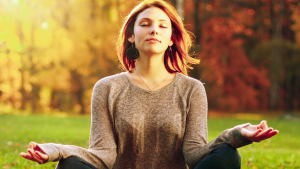
Ayurveda is a holistic health practice that began in India around 5,000 years ago and is still used by practitioners around the world today. It takes a personalized and proactive approach to wellness, tapping into the intrinsic wisdom of nature to restore balance between body, mind, and spirit. According to this healing practice, the five elements of nature (fire, water, earth, air, and space) combine in a unique way to form your personal dosha, or constitution: Vata (air + space), Pitta (fire + water) or Kapha (earth + water).
Fall is a period of transition from Pitta (summer) to Kapha (winter) energy, which is primarily marked by the energy of Vata – cool, windy, rough, light and associated with movement, composed of space and air. The energy of change is palpable in autumn; the passage from one season to another creates a container for possibility, but perhaps not without some agitation.
To balance our physical and emotional health as we move through autumn, it’s important to follow some lifestyle and dietary guidelines to keep the excess vata at bay. (You’ll also need to consider the particular climate where you live – the characteristics of this season may be different to your geography.)

What does Vata imbalance/excess look like?
- Increased anxiety or agitation
- Inability to focus or restlessness
- Poor circulation, aches and pains, muscle tension
- Dry skin, lips, hair and eyes
Finding balance through the Vata energy of autumn can be best achieved with an emphasis on qualities that encourage grounding, focus, stability and warmth. We often gravitate to these practices and foods unconsciously, to some degree; humans and animals are naturally aligned with the rhythms of nature and you might find yourself making choices that promote better balance through the changing seasons. Still, understanding the basics of Ayurveda and observing your own energy, mood, and physical responses to the energies within nature can support you in finding harmony throughout the year.
You can follow these general guidelines to find better balance in body, mind, and spirit this autumn, amending as required for your own personal needs:
FOODS TO FAVOUR
- sweet, sour & salty
- steamed veggies & healthy fats
- soups & stews
- wholesome & hearty foods
- carrots, yams, beets
- avocado, dates, lemon
- quinoa, brown rice, kidney beans
- lots of ghee, olive oil, almond oil
- turmeric, basil, ginger
FOODS TO AVOID
- raw veggies
- cold or frozen foods
- bitter, pungent & astringent flavours
- light, cooling, drying foods
- broccoli, cabbage & cauliflower
- white potatoes
- popcorn & millet
- dried fruit
- beans, leafy greens & sprouts
LIFESTYLE & MOVEMENT PRACTICES
Choose slow, intentional, mindful exercise and movement practices that help to pacify excess vata. Keep it simple and focus on establishing practices that support a sense of stability, consistency and groundedness. Generally speaking, it’s wise to avoid high-impact or heat-building activities, as well as fast-moving yoga flows or workouts.
- Focus on exercise and activities that encourage more grounding and centering, like yin or hatha yoga and meditation;
- Create stability and consistency through developing daily routines that support you – journaling is a great way to achieve this;
- In the fall, the best times to work out are early morning and early evening; you might find yourself more focused and centered at these times of day;
- Have you ever noticed the grounding and warmth you manifest through a gratitude practice? Acknowledging the gifts in your life is a beautiful practice for balancing excess vata energy in the fall.
- A weighted blanket and eye pillow can be very calming and restorative additions to your fall self care or relation routines. These items help to soothe and inspire a state of calm.
First and foremost, you should support your own unique dosha when choosing foods, movement and stress management practices. For instance, if you have a vata dosha, you’ll be even more susceptible to the erratic energy of the vata season and prone to an imbalance.
Remember that these are just suggestions; give yourself an opportunity to explore, and through careful observation of the ways your mind and body respond, determine the practices that work best for you.

